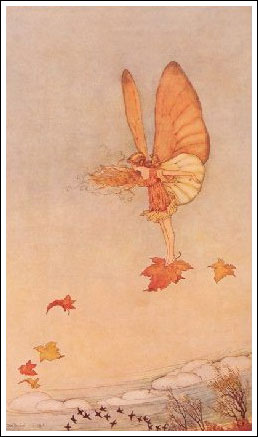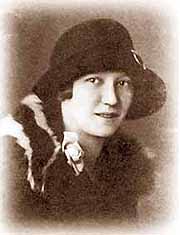|
IDA RENTOUL OUTHWAITE (1888-1960)
Ida Sherbourne Rentoul was born in
Melbourne, Australia on June 9, 1888 to Annie Isobel Rattray
and John Laurence Rentoul, a Professor at the University of
Melbourne. She was a talented artist at a young age and
together with her sister, Annie Ratrey Rentoul (b. 1882),
produced books for children while still attending primary
school.
It has been claimed that Ida was able to
draw birds before the age of two and was able to copy the
images off her nursery walls.
Later, Ida's parents decided not to send
the budding artist to art lessons because they felt it would
stifle her imagination. However, Ida, had different ideas
and was quoted as saying, “I used to find great difficulty
in drawing feet in those days, and was almost in despair
until I hit on the happy plan of hiding them in deep
luxuriant grasses (which was no doubt very wicked). I just
had to plod along without having any teaching, which was a
pity. I should have been a much better artist if I could
have studied more and amused myself less.”
As a young woman, she attended
Presbyterian Ladies' College in Melbourne.
In December of 1909, Ida married Grenbry
Outhwaite, a successful businessman 13 years her senior. He
bought a large house in Melbourne and commissioned a studio
to be built in the garden for Ida.
Outhwaite’s production declined slightly
during the next several years, during the period she bore
her husband four children. Her book, The Enchanted Forest
written by Grenbry and published in 1921, was dedicated to
her children, for which they also served as models.
A magazine called the New Idea
published Ida’s first professional illustration in August of
1903 when she was just 15 years old. It accompanied a story
entitled The Fairies of Fern Gully written by an
author named Billabong, who later turned out to be none
other than older sister Annie. This collaboration of the
Rentoul sisters was a natural outgrowth of their many artful
childhood projects. Although Annie was more scholastically
inclined, and taught school, she would always find just the
right words to accompany Ida’s images.
A planned trip to England was postponed
due to the outbreak of World War I. Grenbry had hoped to
exhibit Outhwaite’s work in England in order to establish
her reputation there, which he felt was vital to her
success.
|

FAIRY
ART - OUTHWAITE
ARTIST HOME
 Books & Illustrations
-
Mollie's Bunyip (1904)
-
Mollie's Staircase
(1906)
-
Gum Tree Brownie and
other Faerie Folk of the Never Never
(1907)
-
Before the Lamps are lit
(1911)
-
Elves and Fairies (1916)
-
The Enchanted Forest
(1921)
-
Fairyland (1926)
-
Blossom: A Fairy Story
(1928)
|
Instead, in 1916, he partially subsidized his
wife’s first published work in color print. The volume, named
Elves and Fairies, was written by Annie. It was a lavish and
ambitious publication at a time when fairy art was virtually unheard
of in Australia. As an act of wartime patriotism, Ida offered her
royalties to the Red Cross. She also presented a copy of the book to
Queen Mary, which gave her the much-needed publicity she needed in
Great Britain.
After the war, Outhwaite had an exhibit in London
at the Fine Art Society. the well known English publisher A &
C Black discovered the two sister’s artistic talent at the exhibit
and published five of her books between 1921 and 1934, all lavish
luxury editions.
Ida’s illustrations later graced postcards of the
era, and eight sets were eventually produced.
Ouitwaite had a style uniquely her own. Her
ethereal, pale, wispy fairies were created with a combination of
pen, ink and watercolor, and usually floated above the earth or in
the water, often in a standing position with arms outstretched. The
fairies are usually floating atop either a leaf, butterfly,
dragonfly, fish, flower or bubble.
The usual setting is the Australian bush, and
many native exotic animals such as kookaburra and koala are included
in the background. Her illustrations were exhibited throughout
Australia, as well as in London and Paris between 1907 and 1933.
By the 1930's, Ida's popularity declined for a
number of reasons. Fairies were no longer in vogue and the printing
techniques for her books had been replaced by better methods, making
her books look obsolete. Also, overall critique of her work
considered her fairy representations to be repetitious and too
romantic. The characters never changed. Her books failed largely
because they were luxury items and fell out of favor during the war.
Publishers weren't willing to pick up production after the war.
Additionally, her sister Annie wrote the books based on the theme of
Ida's paintings, rather than writing a story and presenting it to
Ida to create artwork specifically for, leaving them somewhat weak
on central theme and character.
Isn't it amazing, all the criticism, how much we
miss her lovely work today? Never again will we have a star such as
Ida to craft her lovely paintings for us but we are fortunate to
have such beautiful reminders in the form of her artwork.
Ida's life was not without sorrow. Grenby died in
1938 and she lost both her sons in World War II, the eldest in 1941
and the youngest in 1945. After her daughters left home, she moved
in with her sister Annie and died on June 25, 1960 at age 71. Annie
lived until 1978.
http://www.ortakales.com/illustrators/Outhwaite.html

Imagine, I pray, the sensation and
shock
When a Fairy arrived in a very short frock,
A rose on her shoulder, her nose in the air,
Pert wings and a shingle, instead of long hair.
Annie Rentoul, The Shingle in Fairyland

|



